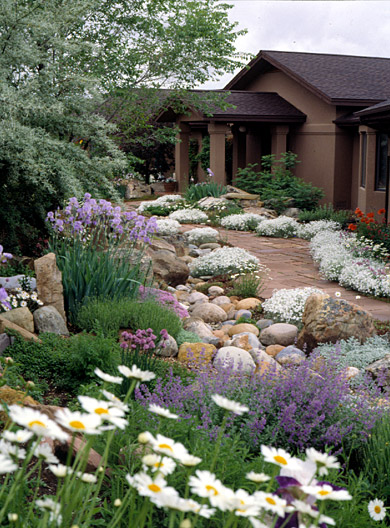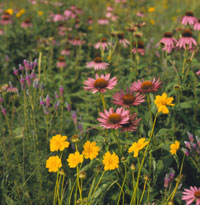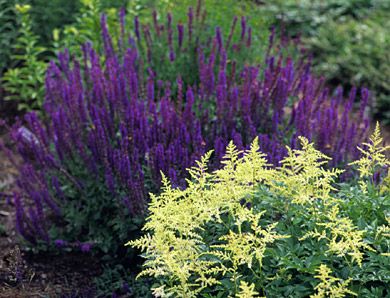





 Look past the idea of a lawn whencreating a low-upkeep landscape.
Look past the idea of a lawn whencreating a low-upkeep landscape.
Give away the lawn mower and forget about reseeding, watering, dethatching, and all of that other traditional yard work. Trade in your turf for an appealing, easy-care lawn.
"Low-upkeep" and "lawn" rarely appear in the same sentence. For most homeowners, the ideal front lawn is green and neat as a Christmas tree. But keeping this lush look demands sacrifice. Do you spend hours seeding, fertilizing, watering, weeding, mowing, dethatching, and aerating to present a public face of perfect turf? Who needs the hassle?
More people are turning to less-care lawns. Across the West, where water is at a premium and water bills are pricey, low-upkeep lawns are already treasured. Instead of traditional, thirsty turfgrass, people rely on beautiful drought-tolerant native groundcovers, flowers, shrubs, and trees that require little or no watering to survive. This landscaping approach, called Xeriscaping, can be applied by anyone anywhere who wants an attractive, environmentally friendly landscape.
Use a stone-bordered raised bed to keep your plants tidy; click here to learn how to install your own.
continue reading below Wildflowers will add color
to your landscape.
Wildflowers will add color
to your landscape.
Although a low-upkeep landscape relies mostly on native plants that can fend for themselves, you will need to prepare the site for planting and do occasional maintenance. Use these tips from landscape designer Steven Williams, landscape architect Charles Seha, and others to help you create a healthy, good-looking lawn with minimal effort.
1. Rely on local experts. Consult a nursery, extension service, or native-plant society for help in choosing the best plants for your landscape. Your choices will depend on the overall effect you desire: a Xeriscape of drought-tolerant plants, a wildflower meadow, or a prairie that combines perennials and grasses.
2. Ensure good drainage. Prepare a new lawn by slightly grading it away from the house. Improve soil drainage by incorporating a 2-inch layer of compost and shredded leaves or bark.
3. Take the plunge. Replace an existing lawn by rototilling it until it disintegrates. Before you plant, many sources recommend that you apply a glyphosate-type weed killer such as RoundUp to prevent aggressive turfgrass from regrowing.
4. Diversify. Include a variety of shrubs, small trees, edible plants, and large rocks for a handsome landscape that will mature into an easy-care display and also attract wildlife.
5. Use mulch to suppress weeds, preserve soil moisture, and build soil. In early summer and late fall, apply a 1- to 2-inch layer of compost, shredded leaves, or shredded bark between plants.
6. Water as little as possible. New plantings need regular watering their first two years. Use soaker hoses that drip water slowly to plant roots. Water once or twice a week during hot, dry weather; water when soil feels dry.
7. Enrich soil to encourage healthy plants. In late spring or early summer, scratch a 1- to 2-inch layer of compost and rotted manure into the soil around plants. Or apply a balanced, slow-release organic fertilizer.
8. Take baby steps. If you're not ready to go all the way, replace only part of your existing lawn with Xeriscape plantings. Alternatively, overseed the lawn with a wildflower or herbal lawn seed mix. Start by aerating the lawn in spring. (Hire someone to do it or rent a core aerator.) Backfill holes in the lawn with compost. Plant seeds according to package directions. Repeat the following spring.
 Purple salvia offers lots of color
and needs little maintenance.
Purple salvia offers lots of color
and needs little maintenance.
Copyright © www.100flowers.win Botanic Garden All Rights Reserved